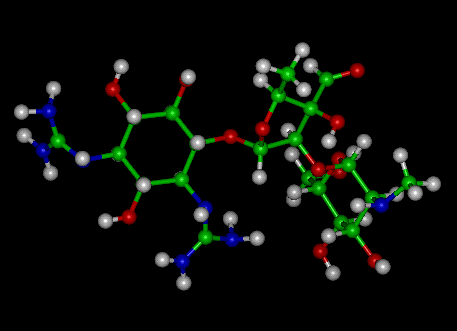Streptomycin
Streptomycin is an antibiotic drug, the first of a class of drugs called aminoglycosides to be discovered, and was the first antibiotic remedy for tuberculosis. It is derived from the actinobacterium Streptomyces griseus. Streptomycin stops bacterial growth by damaging cell membranes and inhibiting protein synthesis. Specifically, it binds to the 16S rRNA of the bacterial ribosome, interfering with the binding of formyl-methionyl-tRNA to the 30S subunit. This prevents initiation of protein synthesis. Humans have structurally different ribosomes from bacteria, thereby allowing the selectivity of this antibiotic for bacteria. Streptomycin cannot be given orally, but must be administered by regular intramuscular injection. An adverse effect of this medicine is ototoxicity. It can result in permanent hearing loss.
History
It was first isolated on October 19, 1943 by Albert Schatz, a graduate student, in the laboratory of Selman Abraham Waksman at Rutgers University. Waksman and his laboratory discovered several antibiotics, including actinomycin, clavacin, streptothricin, streptomycin, grisein, neomycin, fradicin, candicidin and candidin. Of these, streptomycin and neomycin found extensive application in the treatment of numerous infectious diseases. Streptomycin was the first antibiotic that could be used to cure the disease tuberculosis; early production of the drug was dominated by Merck & Co. under George W. Merck. The first randomized controlled trial to be completed and, therefore, the first to be published, it was run by England's Medical Research Council and pitted streptomycin and bed rest against bed rest alone, which was then the standard TB therapy. It accrued its first patients in January 1947.
Treatment of disease
Tuberculosis
in combination with other anti-TB drugs. It is not the first line
treatment.
Plague (Yersinia pestis) has historically been treated with it as
the first line treatment. It is approved for this purpose by the
U.S. FDA.
Infective endocarditis caused by enterococcus when the organism
is not sensitive to Gentamicin
In veterinary medicine, streptomycin is the first line antibiotic
for use against gram negative bacteria in large animals (horses,
cattle, sheep etc.). It is commonly combined with procaine penicillin
for intramuscular injection.
Bacterial selection experiments
When grown on medium containing streptomycin, bacteria such as Escherichia coli are dependent upon expression of the aadA gene in order to survive (Joung et al., 2000). Thus, a suitably engineered E. coli strain, can be combined with a streptomycin-doped medium to select only bacteria hosting a successful interaction in two-hybrid screening experiments and methods derivative of two-hybrid screening (Hurt et al., 2003; Joung et al., 2000)
Pesticide
Streptomycin is also used as a pesticide, to combat the growth of bacteria, fungi, and algae. Streptomycin controls bacterial and fungal diseases of certain fruit, vegetables, seed, and ornamental crops, and controls algae in ornamental ponds and aquaria. A major use is in the control of fireblight on apple and pear trees. As in medical applications, extensive use can be associated with the development of resistant strains.
References
- Hurt, J. A., S. A. Thibodeau, A. S. Hirsh, C. O. Pabo and J. K. Joung (2003). "Highly specific zinc finger proteins obtained by directed domain shuffling and cell-based selection." Proc Natl Acad Sci U S A 100(21): 12271-6.
- Joung, J. K., E. I. Ramm and C. O. Pabo (2000). "A bacterial two-hybrid selection system for studying protein-DNA and protein-protein interactions." Proc Natl Acad Sci U S A 97(13): 7382-7.
- Kingston, William (2004). Streptomycin, Schatz v. Waksman, and the Balance of Credit for Discovery. Journal of the History of Medicine and Allied Sciences 59 (3), 441-462.
- Mistiaen, Veronique. Time, and the great healer. The Guardian, Saturday 2 November 2002. The history behind the discovery of streptomycin.
- Lawrence, Peter A. (2002). The misallocation of credit is endemic in science. Nature 415 (6874), 835-836.
- EPA R.E.D. Facts sheet on use of streptomycin as a pesticide.

